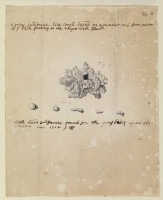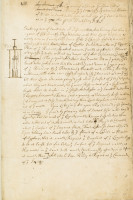Calculi, glade of light, instrument
Date
1706
Creator
Unknown, Engraver
Creator - Organisation
The Royal Society, Publisher
Object type
Article identifier
Material
Technique
Subject
Description
4 figures from issue 305 of Philosophical Transactions of the Royal Society.
Figures 1-2. Two anatomical studies, showing a bony substance found in a tumour in the neck of a fifty year old woman (1), and various small white calculi found in the prostate of an old man (2). Illustrations to ‘An account of a very large tumour in the fore part of the neck, &c’ by James Douglas in Philosophical Transactions of the Royal Society, vol.25, issue 305 (March 1706). Original proofs of this illustration can be found in MS/131/104.
Figure 3. Astronomical study of a ‘glade of light’ in the Taurus constellation, as observed by William Derham in March 1706. Illustration to ‘Part of a letter from the Reverend Mr W. Derham, F. R. S. concerning a glade of light observed in the Heavens’ in Philosophical Transactions of the Royal Society, vol.25, issue 305 (March 1706).
Figure 4. Instrument made and used by Francis Hauksbee in his experiments on the capillary rise of water in small tubes. Illustration to ‘An experiment made at Gresham-College, shewing that the seemingly spontaneous ascention of water in small tubes open at both ends is the same in vacuo as in the open air’ in Philosophical Transactions of the Royal Society, vol.25, issue 305 (March 1706). Original proof of this illustration can be found in Classified Papers of the Royal Society CLP/18i/98.
James Douglas (1675-1742), British physician, was elected a Fellow of the Royal Society in 1706; William Derham (1657-1735), British Church of England clergyman and natural philosopher, was elected a Fellow of the Royal Society in 1703, and; Francis Hauksbee (bap. 1660, d. 1713), British natural philosopher and scientific instrument maker, was elected a Fellow of the Royal Society in 1705.
Figures 1-2. Two anatomical studies, showing a bony substance found in a tumour in the neck of a fifty year old woman (1), and various small white calculi found in the prostate of an old man (2). Illustrations to ‘An account of a very large tumour in the fore part of the neck, &c’ by James Douglas in Philosophical Transactions of the Royal Society, vol.25, issue 305 (March 1706). Original proofs of this illustration can be found in MS/131/104.
Figure 3. Astronomical study of a ‘glade of light’ in the Taurus constellation, as observed by William Derham in March 1706. Illustration to ‘Part of a letter from the Reverend Mr W. Derham, F. R. S. concerning a glade of light observed in the Heavens’ in Philosophical Transactions of the Royal Society, vol.25, issue 305 (March 1706).
Figure 4. Instrument made and used by Francis Hauksbee in his experiments on the capillary rise of water in small tubes. Illustration to ‘An experiment made at Gresham-College, shewing that the seemingly spontaneous ascention of water in small tubes open at both ends is the same in vacuo as in the open air’ in Philosophical Transactions of the Royal Society, vol.25, issue 305 (March 1706). Original proof of this illustration can be found in Classified Papers of the Royal Society CLP/18i/98.
James Douglas (1675-1742), British physician, was elected a Fellow of the Royal Society in 1706; William Derham (1657-1735), British Church of England clergyman and natural philosopher, was elected a Fellow of the Royal Society in 1703, and; Francis Hauksbee (bap. 1660, d. 1713), British natural philosopher and scientific instrument maker, was elected a Fellow of the Royal Society in 1705.
Related fellows
James Douglas (1675 - 1742, British) , Physician, Physician
William Derham (1657 - 1735, British) , Clergyman
Francis Hauksbee (1688 - 1763, British) , Instrument maker
William Derham (1657 - 1735, British) , Clergyman
Francis Hauksbee (1688 - 1763, British) , Instrument maker
Associated place

